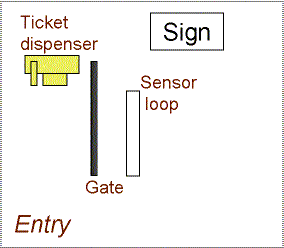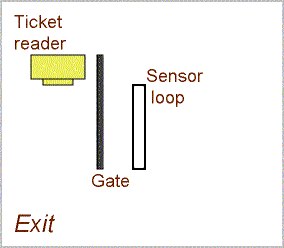University of Oregon
|
A parking garage has 500 spaces, two entries, and two exits.
 |
An entrance consists of a ticket dispenser with a button, an electronic sign which displays either "space available" or "no space available", a gate that can be raised to let a car pass, and a sensor loop which senses that a car has passed through the gate.
If the sign displays "no space available", then the gate should remain down, and pressing the ticket dispenser button has no effect. If the sign displays "space available", then pushing the button results in dispensing a ticket and raising the gate. The gate is lowered when the car passes over the sensor loop. For this exercise you may assume that, if a ticket is dispensed, the car will always enter the garage. (In real life we would have to consider the case of cars that pull out of the entry and leave without entering the garage.) |
 |
An exit consists of a ticket reader, a gate that opens when the ticket has been read, and a sensor loop. When a validated ticket is placed in the ticket reader, the gate raises to let the car pass. When the car passes over the sensor loop, the gate lowers again. |
The number of cars in the garage is defined as the difference between the number of cars that have entered and the number of cars that have left. The number of cars in the garage cannot be negative, and it must never exceed the total number of spaces in the garage.
The two entries and two exits must operate concurrently; it is not acceptable to "freeze" one of the entries or exits for the entire duration of a transaction at another entry or exit. However, there are potential race conditions. For example, if there is just one space available in the garage (499 spaces are occupied), only one car can be admitted to the garage. Your job is to design the synchronization structures of the garage in such a way that
To the extent possible, you should also try to achieve the following design goals:
You may assume that, after the entry button is pressed and a ticket has been dispensed, a car will proceed through the entry gate. You may assume that, after a ticket is presented at the exit gate and the gate opens, a car will proceed through the exit gate. Do not assume more about the behavior of cars.
You may not introduce additional sensors or actuators in the garage. For example, you may not introduce sensors in the parking spaces themselves, in the tickets, or in the cars.
Turn in on paper:
Turn in by email:
For this exercise you are allowed and encouraged to collaborate. Solutions may be produced by individuals or teams of 2. Teams may communicate. I suggest you use the February 2 class meeting to discuss progress and problems.
The Promela source code that you turn in must include prominent notice of any external sources and of collaboration. For example, if you arrived at your solution after discussing general strategies with Jill Dougherty, and Sam Peckinpah helped you understand some obscure feature of Promela, then your Promela source code should credit Jill and Sam for their help. If you based your solution partly on the pathfinder example that comes with Spin, then that should also be noted prominently. I am very strict about these rules --- omitting proper credit transforms allowed collaboration into plagiarism.
Think first, before you code. This is as important for building and verifying models as it is for writing "normal" programs, perhaps more so.
Start small. Really small. Add incrementally to your model, little by little.
Make sure you understand what is wrong before you try to fix it. Random perturbations of your models will not help.
Don't be afraid to throw it away and start over.